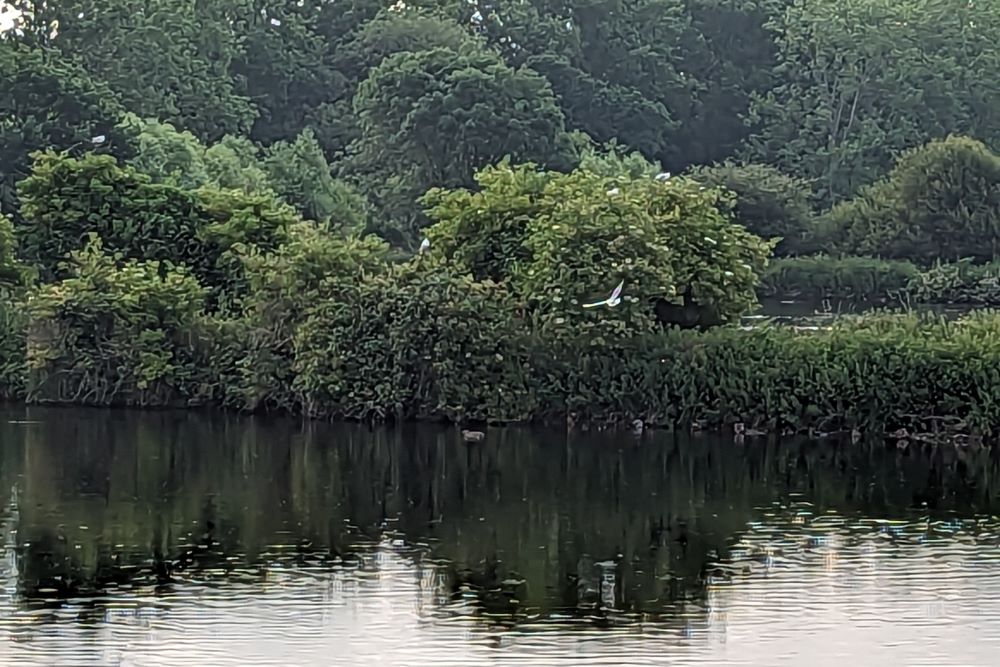Observations

Quieter than usual on the rafts as In Flew Enza
A review of the birds of May-June 2023
This is the period in the RMRG calendar year in which the focus is firmly on breeding surveys – counting and mapping singing males, finding nests, checking nestboxes, counting broods of ducklings and so on. Early indications on the breeding season are mixed, with some species appearing in fewer numbers, some showing poor productivity, but some doing better.
The sounds of Rye Meads at this time of year are dominated by the Black-headed Gull colony, but this year has been quieter. Less than half last year’s number of gulls showed up, and once again losses from predation were high. To make matters worse, there was an outbreak of HPAI – Bird Flu – that mainly affected the gulls: perhaps 12-15 birds were found dead, although it is suspected these were mainly birds passing through rather than our breeders. A few bred on the much smaller rafts in the South Lagoons, and interestingly four or five pairs nested on the bushes beside the lagoons in the South, something we haven’t seen here before!
The Common Terns also appeared in much smaller numbers and there were only two breeding attempts, both of which failed. Have the gulls and terns suffered such losses over the winter that there are so many fewer to return, or are they more wary following last year’s mass predation of nests? More information is needed.
There were decent numbers of wildfowl around, and pleasingly they seemed largely free of bird flu. Canada Geese, Greylags and Egyptian Geese all bred, and there were a pair of Garganeys intermittently and up to six Red-crested Pochards.
There were regular visits by up to seven Oystercatchers, and a Spring peak of five Little Ringed Plovers. However, as with the three or pairs of Lapwings, there was no successful breeding.
Of the occasional visitors, we enjoyed a single Dunlin twice, four Black-tailed Godwits, a Common Sandpiper and a Wood Sandpiper, as well as a smattering of single Redshanks. The first returning Green Sandpiper was back in early June, with 2-3 birds regular by the end of the month.
Probably the star bird of the period was the Grey Partridge, unexpectedly found near the Draper Hide one morning in May: our first record since 1998!
There were up to three Cuckoos recorded, and we probably had two males and two females in the area. At least three chicks have been reared by hard-working foster parents. Both Tawny Owl and Barn Owl have also bred on site.
Amongst the raptors, top spot went to the Osprey in early May – these passage migrants are not quite annual at Rye Meads and this was the first for four years. There were three May records of Marsh Harrier, then a resident female spent June with us over the Meadows, recognisable by a distinctive missing flight feather. The other regular raptors were – er, regular. Hobbies were generally fewer than usual this year with 1-3 birds intermittently through the period. A pair of Ravens paid us a visit in May but were not seen again.
The Spring maximum of Swifts proved to be 60 birds, and maxima of the Hirundines were eight Sand Martins, 14 Swallows and 15 House Martins, pretty modest by former standards.
The usual warblers were present on site and breeding, although with just a single record, Grasshopper Warbler may not have bred this year. Also there were just four records of Lesser Whitethroats. Treecreepers may have bred either on site or nearby: there were only three records of this secretive species, but we’ve already caught some juveniles. More unexpected visitors were the two Whinchats which paused on passage with us, and a rare May Skylark.
Starlings have already coalesced into their post breeding flocks, with up to 130 seen. Of the finches, maximum counts were likely to represent breeding birds, with four Chaffinches, seven Greenfinches, four Linnets and nine Goldfinches. Sadly it’s likely that Bullfinch is now extinct as a breeding species at Rye Meads, with just three records of one or two birds.
For more information on observations and ringing, delivered much more up to date in our bi-monthly Bulletin, why not become a Friend of RMRG?
